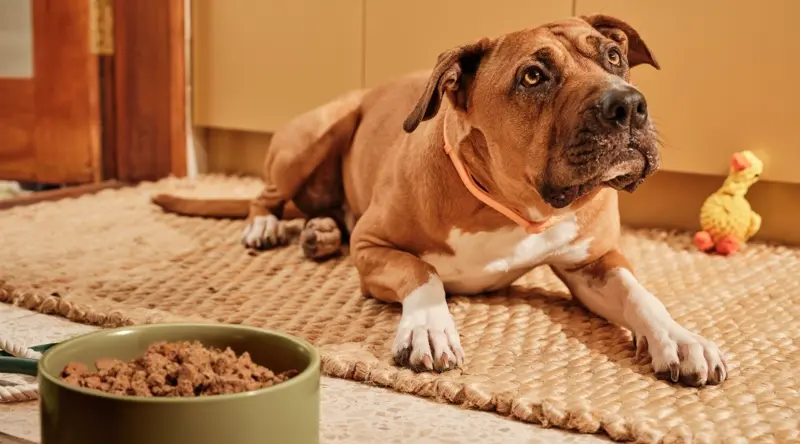They may be compact and muscular, but Australian Bulldogs are all heart — brimming with charm, loyalty, and a natural sense of protectiveness. Endearingly expressive and attuned to their humans, they bring a family-first energy to any home.
But that big-hearted nature can come with a few quirks. Training an Australian Bulldog isn’t about control — it’s about connection. In this guide, we unpack what makes this breed tick, and how to nurture focus, trust, and good habits without losing their relaxed but cheeky spark. From positive reinforcement to food that fuels brainpower, here’s how to bring out the best in your devoted sidekick.
Read more: Australian Bulldog breed insights: care, personality, and expert tips
Australian Bulldog temperament and trainability
Australian Bulldogs are typically calm, courageous, and affectionate. They form strong bonds with their humans and thrive on being part of the family. While they’re intelligent, they can also be a bit stubborn — which means consistent, reward-based training is essential.
Start early and keep things positive. These dogs respond best to patience and plenty of praise. Positive reinforcement helps build their confidence and makes them more likely to engage in learning.
)
Health considerations that can affect training
Australian Bulldogs are adaptable dogs, but a few breed-specific health issues can affect their comfort, focus, and overall trainability.
They’re particularly prone to:
Joint conditions
Joint problems, like hip dysplasia (a condition where the ball and socket of a dog’s hip joint haven't developed properly), can affect your dog's health and inclination to exercise and train. Instead of moving smoothly, the joint grinds and rubs, leading to inflammation, pain, and reduced mobility. Over time, this can result in arthritis or more severe joint damage.
Joint discomfort often shows subtly at first, like slower movement or hesitation during training, before becoming a more serious barrier to exercise and focus.
Try this:
Include dietary ingredients with anti-inflammatory properties, like turmeric, ginger, and omega-3 fatty acids from fish oil or green-lipped mussels to help support joint health.
Read more: Hip dysplasia: how can your dog's diet help?
Brachycephalic obstructive airway syndrome (BOAS)
An Australian Bulldog's flat face and shortened airway can lead to breathing difficulties and reduced exercise tolerance.
Try this:
Avoid over-exercising your pup, especially in hot weather, as they can overheat quickly. Keep training sessions short and conduct them in the cooler morning temperatures.
Obesity
Excess weight, resulting from overfeeding and under-exercising, can be a common problem. Carrying extra kilos can put stress on joints and affect your Bulldog’s breathing, decreasing their motivation to exercise and ability to focus and impacting their health.
Try this:
Opt for custom-portioned, nutrient-dense meals that provide steady energy without excess calories, like Lyka.
Read more: Lyka's vet guide to healthy dog weight (with charts and video)
If your Bulldog seems lethargic, distracted, or reactive, it may be worth consulting your vet to rule out underlying health conditions.
)
How real food fuels your Australian Bulldog’s focus
Just like us, dogs learn best when they’re feeling healthy, balanced, and energised. Diet plays a big role in your pup’s ability to focus, stay calm, and retain information.
Australian Bulldogs benefit from:
Steady energy sources like butternut squash and purple sweet potato, which have a low glycaemic load and help release energy slowly.
Essential fatty acids like DHA and EPA (omega-3s from fish, mussels, or fish oil), which support brain health and development, memory, and learning
Fresh, bioactive nutrients, from ingredients like blueberries and shiitake mushrooms, to support immunity, skin health, and overall wellbeing
“A fresh food diet packed with brain-boosting nutrients supports your dog’s ability to learn and adapt. Omega-3s, especially DHA, are critical for memory and cognitive function.”
– Dr Alex England, Lyka Veterinarian, BVetMed MANZCVS (Small Animal Veterinary Practice)
Learn more about Dr Alexander England and his veterinary experience.
All Lyka meals are formulated by Board-Certified Veterinary Nutritionists to provide complete and balanced nutrition for learning, growth, and everyday health.
Read more: What does an Australian Bulldog eat? Breed-specific nutrition tips
Read more: Fuelling your dog’s focus: how nutrition impacts your dog’s training
Exercise first for improved focus
Australian Bulldogs may not need marathon runs, but regular walks and play sessions help release excess energy and improve focus during training. Try short morning walks or a gentle sniffari to explore the scents at the local dog park.
Training tips for Australian Bulldogs
Training an Australian Bulldog can be equal parts comedy and chaos — but with patience and a playful approach, it’s incredibly rewarding.
Keep sessions short, sweet, and full of positive vibes. Here’s what works best:
Positive reinforcement
This is the gold standard for training. Marking good behaviour with rewards like praise, affection, treats, or continued interaction teaches your pup how to behave and supports a strong and positive relationship.
Double up on rewards to mark excellent responses from your Australian Bulldog, like praise and a pat, or praise and a treat.
Find their favourite motivator
Discovering your pup’s hierarchy of high-value rewards is a great way to keep your Australian Bulldog motivated. Is it a nibble of roast chicken, their favourite squeaky toy, or playtime with you?
Train at the right time
Sometimes dogs don’t have the energy or desire to learn, especially if they’re too tired, too full, or hot and bothered.
Mental enrichment through training can be tiring for dogs, so find the right time to train and stop if you notice your dog starting to lose focus or fatigue.
Stay consistent
Consistency is key to training. Not just in setting your expectations, but in using the same verbal and non-verbal cues.
Be playful and engaging
Dogs are sensitive souls that can pick up on your mood. Keep your sessions fun so your positive energy will be contagious.
Watch their body language
If your pup starts to show signs of stress or tiredness, give them a break. If they’ve reached saturation point, it can be counterproductive to persevere. You can always come back to the training at another time.
Training your Australian Bulldog puppy
Australian Bulldog puppies are delightfully cheeky and full of curiosity — but don’t expect instant results. House training is usually top of the list, followed closely by socialisation and basic obedience cues like sit, stay, and leave it.
What works?
A regular toilet routine
Positive crate training for safe sleep and downtime
Early and controlled socialisation with people, dogs, sounds, places and situations
Australian Bulldogs are especially sensitive to harsh corrections, so stick with force-free methods that build trust and confidence.
Read more: Force-free puppy training: what the experts want you to know
)
Training your adult Australian Bulldog
Just because your Australian Bulldog’s out of puppyhood doesn’t mean the training stops. In fact, ongoing mental stimulation is essential to keep their mind sharp and behaviour balanced.
This might look like:
Reinforcing polite greetings at the door
Learning new tricks or games
Adjusting to life changes, like moving house
Training for mobility support, like using a ramp in senior years
Dogs have neuroplasticity, meaning their brains adapt and change making them lifelong learners. Keep training light and engaging, and celebrate progress, no matter how small.
Read more: Training adult dogs: expert tips to boost learning, brain health & bonding
When to call in a trainer or behaviourist
Not sure if your Australian Bulldog’s quirks are just stubbornness — or something deeper?
A trainer is your go-to for obedience, manners, and routine behaviours. A qualified behaviourist, on the other hand, is best for issues like:
Reactivity
Anxiety or phobias
Aggression
Resource guarding
They work closely with your vet to address underlying causes and create a tailored plan. The earlier you seek support, the easier it is to create lasting change.
“If training your dog is very challenging, it may be worth considering a trainer or a behaviourist. A trainer can help you identify what may be triggering their behaviour and show you how to help your dog cope in those situations. The solution may be as simple as reframing what we expect from our dogs and our behaviours around them.”
– Laura V, qualified dog behaviourist
New to Lyka? Let’s rethink dog food together
Training your Australian Bulldog is a journey — one that requires consistency, creativity, and compassion. Whether you’re navigating house training with a stubborn puppy or teaching your senior dog new routines, every small win is a step toward a calmer, more connected life together.
And remember, a well-fed brain is a trainable brain. Supporting your Australian Bulldog’s learning with fresh, real food meals helps unlock their full potential.
Lyka nourishes hundreds of Australian Bulldogs across Australia – from energetic pups to seniors in their golden years – they’re all thriving on Lyka.
)
)
)

)
)
)
)
)
